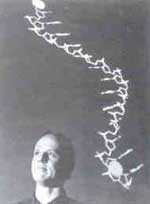Disease detector
 WITH threats of fatal diseases and genetic disorders on the rise, genetic testing becomes an essential tool in diagnosing an ailment or assessing the possibility of a person acquiring one. However, being prohibitively expensive, such speculative genetic screening is restrict- ed to patients in research projects or to those with a family history of the disease.
WITH threats of fatal diseases and genetic disorders on the rise, genetic testing becomes an essential tool in diagnosing an ailment or assessing the possibility of a person acquiring one. However, being prohibitively expensive, such speculative genetic screening is restrict- ed to patients in research projects or to those with a family history of the disease.
But researchers in USA have recently made some advances that brighten the prospects of screen- ing thousands of genes instantan- eously, thus allowing cheaper, rapid genetic tests for certain diseases on a large scale (Scientific American, Vol272, No 5).
Chemist Thomas J Meade and mol- ecular biologist Jon F Kayyem of the California Institute of Technology linked atoms of ruthenium, a heavy metal, to ribose, the sugar component of the DNA molecule without distorting its overall shape.
The ruthenium doped DNA double-helix acted like a piece of live electrical wire. Contrary to the estimation that DNA molecule will conduct up to hundred electrons a second, the current was up by 10,000 times, conducting over a million electrons a second.
Researchers discovered that this new property of DNA molecule to create a highly conductive path could help distinguish among different DNA sequences. Thus, the technique could hasten cheaper and accurate testing of genes for certain diseases.
Using this technology, a synth eticruthenium DNA strand could be used to search for a particular gene sequence associated with a specific disease.
If a matching complementary strand from the disease-causing organism, for instance, virus, were a present, it would bind firmly to the synthetic single DNA strand, built specifically to duplicate any known sequence. This would cause a high flow of electrons to take place along the molecule's axis and the molecule will light up instantaneously like an electrical indicator.
In case the genetic sequence under search is absent, no current would flow and so the detector would not glow.
Meade suspects that a device based on such ruthenium-linked DNA would require "between 15 and 20 bases of single-chain DNA deposited on a chip (of silicon)." Such a device, hopes Meade, could allow simultaneous. detection of hundreds of genes.
